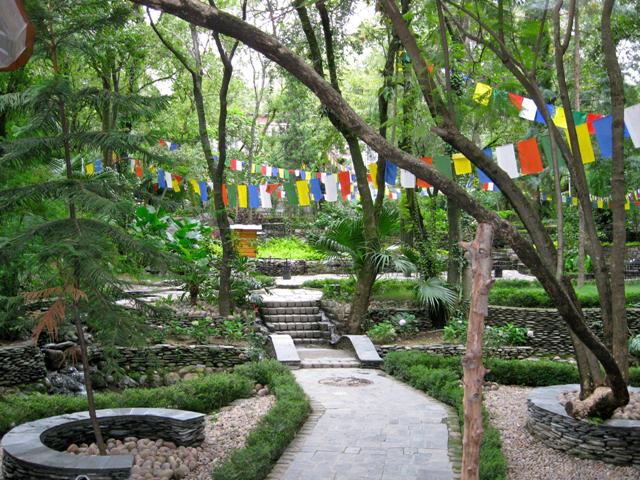The following blog post was written by former full-time Guide Harry Einhorn who is currently studying the Tibetan language at the Deer Park Institute in Bir, Himachal Pradesh, India.
Norbulingka is a premier art school and institute dedicated to the traditional visual arts of Tibet. It is located about one hour outside of Dharamsala, India, the seat of the Dalai Lama and Tibetan government in exile. I recently had the chance to visit this beautiful place, take a tour, and learn a bit about how they train their students.
 The school is situated on some of the most beautiful gardens I have seen in India. Interestingly, the landscaping was done by a Japanese designer.
The school is situated on some of the most beautiful gardens I have seen in India. Interestingly, the landscaping was done by a Japanese designer.
 Here is a side view of the school itself. The thangka painting happens of the top floor. Notice the koi pond down below.
Here is a side view of the school itself. The thangka painting happens of the top floor. Notice the koi pond down below.
 Makara water spouts! Most likely not traditional Tibetan architecture, but with India’s monsoon, a necessity.
Makara water spouts! Most likely not traditional Tibetan architecture, but with India’s monsoon, a necessity.
 The main Thankga painting room had a hushed and meditative atmosphere. The painters’ concentration was palpable. The course of study is three years, including two years of scripture classes. There is an initial drawing test for all applicants. In the mornings, all of the painters chant together, and then will often do am individual practice based on the deity they are painting.
The main Thankga painting room had a hushed and meditative atmosphere. The painters’ concentration was palpable. The course of study is three years, including two years of scripture classes. There is an initial drawing test for all applicants. In the mornings, all of the painters chant together, and then will often do am individual practice based on the deity they are painting.
A mounted Thangka-in-progress. The background is finished, but the figures still need to be filled in. Notice the color testing on the wooden frame.
 And here is a canvas-in-progress stretched out and mounted from the back.
And here is a canvas-in-progress stretched out and mounted from the back.
 Artists in training begin by drawing the outline of the painting on a piece of paper. Then, they perforate the lines with a small pin…
Artists in training begin by drawing the outline of the painting on a piece of paper. Then, they perforate the lines with a small pin…
 … and transfer the image to the canvas by rubbing charcoal over it. The outline is now ready to be filled in.
… and transfer the image to the canvas by rubbing charcoal over it. The outline is now ready to be filled in.
 At Norbulingka, one artist works on one painting. A smaller, 18 inch canvas takes about a month and a half to complete, while a larger one, pictured here, can take a full year. Each individual artist is responsible for mixing his own paints, often made of precious and semi-precious stones.
At Norbulingka, one artist works on one painting. A smaller, 18 inch canvas takes about a month and a half to complete, while a larger one, pictured here, can take a full year. Each individual artist is responsible for mixing his own paints, often made of precious and semi-precious stones.
 All students start with the image of Shakyamuni Buddha. As they progress in their studies, they move on to more complicated forms like wrathful deities and mandalas. In this workshop, students and masters work side by side.
All students start with the image of Shakyamuni Buddha. As they progress in their studies, they move on to more complicated forms like wrathful deities and mandalas. In this workshop, students and masters work side by side.
 A monk comes to inspect a painting. As was the case in Tibet, all the artwork is made on a commission basis, the subject being determined by the buyer.
A monk comes to inspect a painting. As was the case in Tibet, all the artwork is made on a commission basis, the subject being determined by the buyer.
That’s all for now. Stay tuned for fabric thangkas, woodworking, and the metal studio!



